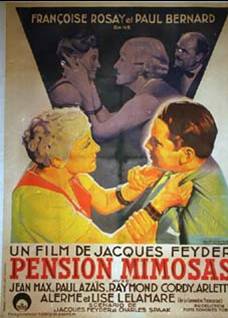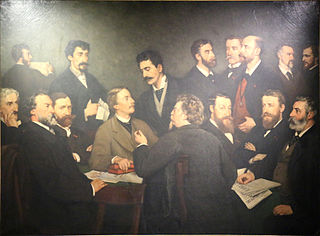
"La Marseillaise" is the national anthem of France. The song was written in 1792 by Claude Joseph Rouget de Lisle in Strasbourg after the declaration of war by France against Austria, and was originally titled "Chant de guerre pour l'Armée du Rhin".
Quebec French is the predominant variety of the French language in Canada, in its formal and informal registers. Quebec French is used in everyday communication, as well as in education, the media, and government.
Marie-Angélique Josèphe Brûlon, née Duchemin, was a French soldier.

Providence is a 1977 French/Swiss film directed by Alain Resnais from a screenplay by David Mercer. It explores the processes of creativity through a portrayal of an ageing novelist, played by John Gielgud, who imagines scenes for his latest novel which draw upon his past history and his relationships with members of his family. The film won the 1978 César Award for Best Film.
Ecclesiam a Jesu Christo was a Papal bull promulgated by Pius VII in 1821.
The Prix Alain-Grandbois or Alain Grandbois Prize is awarded each year to an author for a book of poetry. The jury is composed of three members of the Académie des lettres du Québec. It is named after writer Alain Grandbois.
Chrétien du Bois (1597-1655) was a French official in the Comté of Coupigny. Although many translations exist of his original name, the correct variations are Guislain or Ghuislain. Many languages were spoken in the region, Old French, Dutch, German, and Corsican since Flanders area was part of the Spanish Netherlands.

Baron Édouard-Émile-Albert de Laveleye was a Belgian mining engineer, financier and writer. He was son of Émile de Laveleye (1822-1892) the Belgian economist.
The Walloon Movement traces its ancestry to 1856 when literary and folkloric movements based around the Society of Walloon language and literature began forming. Despite the formation of the Society of Walloon Literature, it was not until around 1880 that a "Walloon and French-speaking defense movement" appeared, following the linguistic laws of the 1870s. The movement asserted the existence of Wallonia and a Walloon identity while maintaining the defense of the French language.

The Académie Royale de Danse, founded by Letters Patent on the initiative of King Louis XIV of France in March 1661, was the first dance institution established in the Western world. As one of King Louis’ first official edicts after the death of royal adviser Jules Mazarin, the “Letters Patent of the King to Establish a Royal Academy of Dance in the City of Paris” represented a critical step towards the young King's wielding of consolidated personal power. Structurally, the Académie consisted of thirteen dancing masters selected by King Louis XIV for being the “most experienced in the Art [of dance].” This "experience" was determined by each dancer's history of success in previous royal productions of ballets de cour. Most famously, eight of the selected dancing masters performed with King Louis XIV during his portrayal of Apollo, the Sun King, in LeBallet de la nuit (1653). Although the object of the Académie was to reflect, analyze and normalize matters of dance, no document relating to its activity or to this theorization has survived. The Académie Royale de Musique, founded in 1669 as the Académie d'Opéra, was a closely related opera and ballet company, and although the two institutions never merged, members of the dance academy were also associated with the opera. Little by little, recruitment of dancers into the royal entourage gave way to recruitment into the ballet-corps of the Opéra. This slowly altered the Académie's profile, making it and its members more dedicated to dance training alone. By 1775, the Académie was nearing the end of its life. On joining the Académie, Jean-Georges Noverre, one of ballet d’action’s most influential choreographers, commented on its ineffectiveness in making meaningful contributions to the dance world. Along with many other royal institutions, the dance academy ceased to exist at the time of the overthrow of the monarchy in 1789, but the opera and ballet company survived and today is known as the Opéra National de Paris.
Charles Ambroise de Caffarelli du Falga (1758–1826), baron Caffarelli, was canon of Toul before the French Revolution and one of the Caffarelli brothers. He became prefect under the First French Empire, then a member of the general counsel of Haute-Garonne. He was notably Prefect of the Ardèche, Calvados and Aube.

The Manifesto for Walloon Culture, was published in Liège on 15 September 1983 and signed by seventy-five "key figures in artistic, journalistic and university circles" of Wallonia.

Pension Mimosas is a 1935 French film directed by Jacques Feyder. Based on an original scenario by Feyder and Charles Spaak, it is a psychological drama set largely in a small hotel on the Côte d'Azur, and it provided Françoise Rosay with one of the most substantial acting roles of her career.
Laughter is a collection of three essays by French philosopher Henri Bergson, first published in 1900. It was written in French, the original title is Le Rire. Essai sur la signification du comique.

Charles François Dominique de Villers was a French philosopher. He was mainly responsible for translating the philosophy of Immanuel Kant into the French language.
Le Temps des cerises is a song written in France in 1866, with words by Jean-Baptiste Clément and music by Antoine Renard, extremely famous in French-speaking countries. The song was later strongly associated with the Paris Commune, during which verses were added to the song, thus becoming a revolutionary song. The "Time of Cherries" is a metaphor regarding what life will be like when a revolution will have changed social and economic conditions. It is believed to be dedicated by the writer to a nurse who fought in the Semaine Sanglante when French government troops overthrew the commune.

The Société Libre des Beaux-Arts was an organization formed in 1868 by Belgian artists to react against academicism and to advance Realist painting and artistic freedom. Based in Brussels, the society was active until 1876, by which time the aesthetic values it espoused had infiltrated the official Salon. It played a formative role in establishing avant-gardism in Belgium.
Charles Le Cène (1647?–1703) was a French Huguenot controversialist, in exile in England and the Netherlands after 1685.

Émile Sacré (1844–1882) was a Belgian painter, after whom the Prix Émile Sacré was named.

The terms Anthropopithecus and Pithecanthropus are obsolete taxa describing either chimpanzees or archaic humans. Both are derived from Greek ἄνθρωπος and πίθηκος, translating to "man-ape" and "ape-man", respectively.












